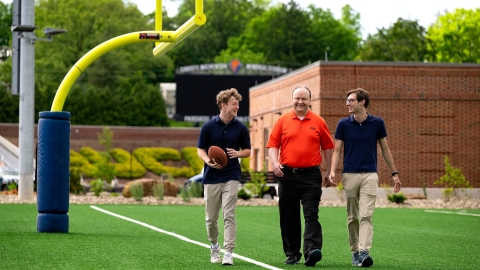
Bucknell Researchers Predict Next NFL Scorigami in New Paper
August 30, 2024
Professors Sam Gutekunst (right) and Joe Wilck (center) discuss an NFL-related research project with student Max Wilson '27 (left). Photo by Emily Paine, Marketing & Communications
NFL scorigamis — a final score combination that has never previously occurred in league history, such as 11-6 or 22-16 — have sparked a cult-like following among football fans and statisticians alike. For many, tracking the emergence of a new scorigami has become a side game almost as thrilling as the game itself, adding to the excitement of a new NFL season this week.
But predicting when and where these elusive scores will appear has always been more of an art than a science — until now, thanks to Bucknell University researchers.
Professor Sam Gutekunst, the John D. and Catherine T. MacArthur Professor of Data Science, along with recent Bucknell graduates Liam Moyer '24 and Jameson Railey '23, and USC Professor Andrew Daw, took on the challenge of scientifically predicting the next NFL scorigami. They are authors on a research paper that offers a fresh approach to forecasting these rare events. The paper has been accepted for presentation at the prestigious Winter Simulation Conference in Orlando in December.
The team's study compares two models: a traditional Poisson random variable (R.V.) model, which has long been a staple in sports score prediction, and a new non-stationary (N.S.) Poisson process model. The latter, developed by the authors, accounts for the dynamic nature of NFL games, incorporating factors such as team strength, strategic decision-making and changes in play as the game progresses.
"Traditional models simplify the game by considering each scoring event independently, but NFL games are much more complex," Gutekunst says. "These traditional models don't capture the impact of factors like team strength or how strategies shift as the game progresses. Our model addresses these dynamics, making it more accurate for predicting scorigamis."
As of the end of the 2023-2024 NFL season, their research found that the probability of a scorigami occurring in a given game was 5.58% according to the Poisson R.V. model and 5.52% with the N.S. Poisson process model. The study identified the most likely scores to become the next scorigami within this framework, with 32-26 and 36-23 emerging as the top contenders.
"Our top prediction is 32-26," says Gutekunst. "If a game ends in a scorigami, that's the most likely score. While the odds are still long — about a one in 60 chance — this score stands out as a good bet compared to other possibilities."
This prediction showcases the subtle differences between the two models. The Poisson R.V. model ranks 36-23 as the most likely new scorigami, with a conditional probability of 1.759%, while the N.S. Poisson process model gives 32-26 the edge with a probability of 1.737%. These slight variations underscore how the models account for the competitive nature of NFL games and the in-game dynamics that make a scorigami more likely to happen.
The research draws from an extensive dataset, utilizing resources like Pro Football Reference and the Python package NFL data, which records detailed play-by-play data for NFL games.
"Our model looks at everything from scoring events to strategic decisions, like how the current score changes whether or not a team attempts a two-point conversion after a touchdown," Gutekunst says. "In our model for predicting scores, we've focused on data from the 2015 through 2023 seasons since that's the last time a major rule change had a notable effect on game dynamics."
The Bucknell team is looking forward to presenting this research in December at the Winter Simulation Conference, which will publish the paper in its peer-reviewed proceedings. The conference is known for its focus on cutting-edge simulation and modeling.
"This project is a great example of academic curiosity intersecting with real-world application," Gutekunst says. "Liam and Jamison were passionate about scorigamis, and together we were able to create something that contributes meaningfully to both the academic community and the world of sports."
As the NFL season begins, fans and bettors alike will be watching closely to see when the next scorigami occurs. When it occurs, the Bucknell researchers will be watching closely to see if it aligns with their predictions.

